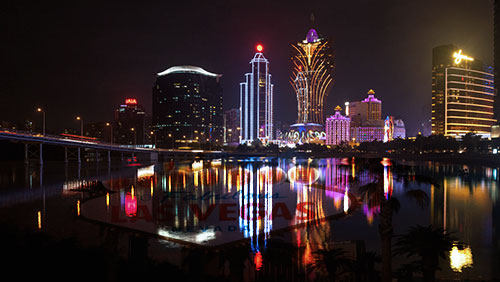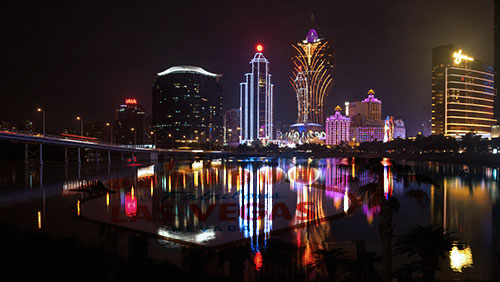 It’s not the earnings that matter as much as the reaction to them that counts. Big misreads by the market do happen sometimes and that leads to massive and sudden moves. But more often then not, stock prices and their trends tend to reflect future earnings on the aggregate. What they are showing, for Macau at least, is that a temporary bottom is in. I still do not believe it is the final bottom, but there may be some time to buy and hold your favorite Macau stocks with fingers on the sell button, ready to run. Personally, if you have any gains I suggest not getting too greedy and locking them in now, if only because Beijing is unpredictable and you don’t want to be holding the bag right when Xi announces more “helpful measures”.
It’s not the earnings that matter as much as the reaction to them that counts. Big misreads by the market do happen sometimes and that leads to massive and sudden moves. But more often then not, stock prices and their trends tend to reflect future earnings on the aggregate. What they are showing, for Macau at least, is that a temporary bottom is in. I still do not believe it is the final bottom, but there may be some time to buy and hold your favorite Macau stocks with fingers on the sell button, ready to run. Personally, if you have any gains I suggest not getting too greedy and locking them in now, if only because Beijing is unpredictable and you don’t want to be holding the bag right when Xi announces more “helpful measures”.
Las Vegas Sands
The only Macau stock in the model portfolio at this point is Las Vegas Sands at a 3% position that was taken on June 28 at $42.50. That’s a 20% gain in 6 weeks, and that’s more than enough. It might go higher, but selling when you’re happy is just as important as buying when you’re scared. That gives us a 0.6% gain overall for the model, not a bad gain for a very conservative move in just a few weeks. Those who want to hold until late September for the dividend payment are doing so at some risk, so unless you have a large holding I suggest foregoing the dividends. If it dips however between now and September 20th and you want to get back in for the dividend, it looks safe to buy hard dips at this point for a decent bounce and collect though. If not, just let it go and move on.
Mainly, the factor that is the most convincing that Macau is safe for the short term, meaning the next 2-3 months (not any longer than that without reassessment), is that the Chinese money supply just took a big jump higher, growing at about a 12% annual clip. This is quite high, so don’t be surprised if you hear news of labor disputes and strikes and protests in the People’s Republic soon. These are always signs of price inflation. Things like this could already be happening without the West even noticing, which might be behind Beijing’s move to silence independent internet journalism recently. The People’s Overlords don’t want complaints to get too loud.
Las Vegas Sands earnings were pretty good, considering the environment. Earnings and revenues are down, which is no surprise as the VIP segment has yet to completely bottom out, but everything else looks temporarily healthy. The fact that the stock was not brought down by lower earnings is also a sign of a temporary bottom. For the exact numbers see their press release, but the highlights that should be mentioned here are that rooms, food and beverage, and mall are all up with operating expenses in these segments up less. That means efficiency is increasing and volumes are rising. Casino may be down, but the traffic is flowing and the mass market is buzzing. One could interpret higher retail as a sign of price inflation, but the fact that operating expenses are down indicates that this may not yet be the case just yet. The Chinese economy seems to be rolling thanks to the printing presses for now.
The big worry with LVS continues to be its debt though. Long term debt is up 9%. Interest rates just keep diving down in a rather scary bond bubble that is obvious to almost everyone at this point. When that pops it’s not going to be good.
MGM
It’s the opposite story in Las Vegas. One could call MGM a Macau stock for its 51% joint venture there, but who are we kidding? We put MGM back into the model portfolio also on June 28th at a 5% position at $22.09. We are now at $24.64 for an 11.5% gain, also good enough. Total portfolio gains from this position are also 0.6%, added in with LVS is a gain of 1.2% in 6 weeks. It’s time to get out of MGM as well for the short term, but for different reasons than LVS. The MGM economic indicator is pointing down now and flashing red as volumes are drying up. This is not surprising as we are in a seasonal downturn in money supply in the United States. It is not that serious this year and may not even end up causing any major stock declines at all, but shrinking volumes and an 11.5% gain already means there is no reason to gamble here. Take the money and run.
The relevant lines from MGM’s new 10-Q fresh off the presses are the following. Casino revenue is up 1% year over year, but ominously, table games volume decreased 9%. The main reason revenue was up is that hold percentage increased, luck basically. There has alo been a decrease in slots volume over the last six months, and main table games are down 3%. All segments are down except rooms, which could also be a sign of budding price inflation in the US. We are certainly ripe for that.
In the end, while visitation to Las Vegas increased by 2% this quarter overall, MGM did not see that increase. MGM may have temporarily topped for now. We can get back in when money supply picks up again, probably around October/November.
Wynn
Wynn Resorts is the opposite story, a strange anomaly. Macau Operations net revenues increased 3.6%, Adjusted Property EBITDA is up almost 10%. Casino revenues in Macau were up 5.2%, though of course VIP turnover continues to tank, down 23.8%. These numbers aren’t affecting stock prices much anymore because everyone knows that VIP in Macau is dead. Again, it’s the reaction to the news that counts, not the news itself.
What is strange about Wynn is that non-casino revenues are down. Room revenue is down 5.8%, occupancy decreased to 91.5% from 96.4%, and REVPAR decreased 5.2%. I don’t know how to explain this in light of LVS success in its non-casino revenues, not that they matter all that much to Wynn as they are comparatively small, but they do indicate economic conditions. It could be linked with simple business strategy, as LVS seems more focused on increasing non-casino revenues while it may not be such a priority for Wynn. In any case, Wynn is too levered to Macau and is much too volatile a stock to take any position in.
